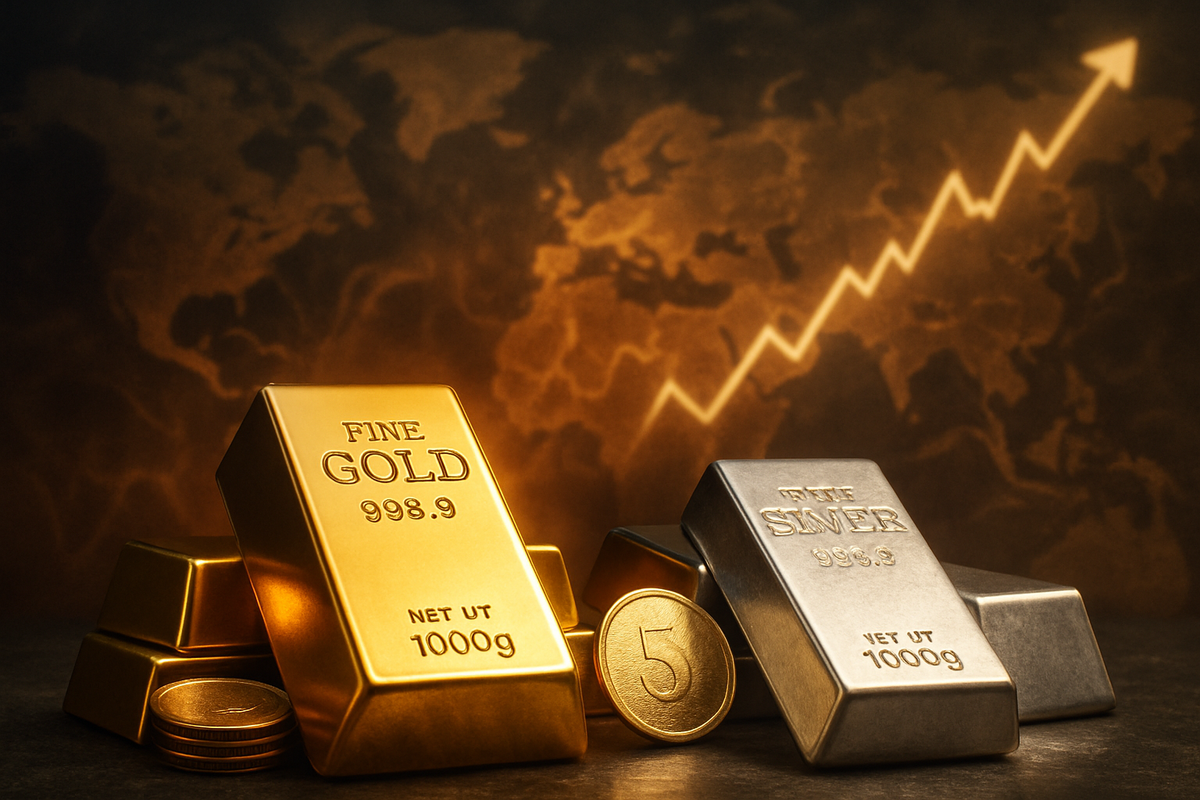
October 6, 2025 – In a dramatic display of market sentiment, both gold and silver have surged to new peak prices today, marking a significant moment for precious metals investors and the broader financial landscape. Gold's spot price eclipsed previous records, reaching an astonishing intraday high of approximately $3,924.39 per ounce, while silver, often seen as gold's more volatile counterpart, touched a fresh 4-year high of $48.75 per troy ounce, closing in on its all-time nominal record. This synchronized rally underscores a profound shift in investor confidence, driven by a cocktail of economic uncertainties, persistent inflationary pressures, and escalating geopolitical tensions.
The simultaneous ascent of these two key precious metals signals a robust flight to safety, as investors seek refuge from turbulent equity markets and the eroding purchasing power of fiat currencies. The immediate implications are far-reaching, potentially reshaping portfolio allocations, influencing central bank policies, and injecting new life into the mining sector. As the global economy navigates a complex web of challenges, the glistening allure of gold and silver has never been more pronounced, prompting a cautious yet keen interest in what these new peaks portend for the future.
A Dual Ascent: Unpacking the Record-Breaking Rally
Today, October 6, 2025, has been etched into the annals of financial history as gold and silver reached monumental new benchmarks. Gold's spot price soared to an intraday peak of approximately $3,924.39 per ounce, with December futures contracts for the yellow metal hitting an even higher $3,973.60 per ounce. This follows a remarkable trajectory, with gold having previously touched $3,788.33 per ounce on September 23, 2025, and around $3,500 per ounce in April of the same year, demonstrating a consistent upward momentum throughout 2025.
Silver's performance has been equally compelling, reaching $48.63 USD per troy ounce and briefly touching a new 4-year high of $48.75. This places the white metal tantalizingly close to its all-time nominal high of $49.95, set way back in January 1980. Silver's journey to these heights has been characterized by sharp gains, having breached the $30 mark on September 13, 2024, and reaching $34.20 on October 21, 2024. The metal notably closed September 2025 at its highest value in history, outpacing even gold's impressive rally.
The primary drivers behind gold's meteoric rise include heightened safe-haven demand amidst fears of a potential US government shutdown and broader global growth concerns. Expectations of further interest rate cuts by the US Federal Reserve have made non-yielding assets like gold more attractive, while a weakening US dollar has further bolstered its appeal. Crucially, significant central bank purchases, particularly from the People's Bank of China, alongside geopolitical and economic uncertainties, have solidified gold's role as a premier safe-haven asset. For silver, its rally is intrinsically linked to gold's performance, but it also benefits from accelerating industrial demand, especially from burgeoning green energy sectors. Persistent global supply deficits, exceeding 100 million ounces annually, have led to critically low inventories and signs of a market squeeze, exacerbated by heavy Indian imports and reduced supply during China's Golden Week.
Mining for Fortune: Winners and Losers in the Precious Metals Boom
The unprecedented surge in gold and silver prices presents a clear boon for companies engaged in precious metals mining, exploration, and refining. These firms are poised to see significant increases in their revenue and profitability, as the value of their primary products escalates. Major gold producers like Barrick Gold (NYSE: GOLD) and Newmont (NYSE: NEM) stand to be among the biggest beneficiaries. Higher gold prices directly translate to fatter profit margins on every ounce extracted, potentially leading to increased dividends, share buybacks, and expanded exploration budgets. Similarly, companies with substantial silver exposure, such as Wheaton Precious Metals (NYSE: WPM), a prominent precious metals streaming company, will see the value of their silver streams and royalties skyrocket. Junior mining companies, often with higher operational costs, could find previously uneconomical deposits now viable, attracting new investment and potentially fueling a wave of mergers and acquisitions in the sector.
Conversely, the impact on other sectors could be mixed. While some investors flock to precious metals, this capital might be drawn away from other asset classes, potentially leading to outflows from equities, bonds, or even cryptocurrencies. Industries heavily reliant on silver as an industrial input, such as electronics, solar panel manufacturing, and automotive production, might face increased raw material costs, which could squeeze their profit margins or necessitate price increases for their end products. Companies like First Solar (NASDAQ: FSLR), for instance, which uses silver in its solar panels, could see their input costs rise. Furthermore, the broader economic conditions driving the flight to safety—such as inflation and economic slowdowns—could negatively impact consumer discretionary spending, affecting a wide range of companies outside the metals sector. However, the overall sentiment that drives precious metals higher often signals broader economic instability, which can have detrimental effects across almost all industries.
The rise in precious metals also has implications for financial institutions and investment funds. Those with significant holdings in gold and silver ETFs or physical bullion will see their asset values appreciate. Conversely, funds that are underweight in precious metals may underperform in a strong commodity market. Speculators and hedge funds that have taken long positions in gold and silver futures and options will be reaping substantial profits, while those betting against the metals will face significant losses. The increased volatility and investor interest could also lead to higher trading volumes for exchanges and brokerage firms, benefiting market infrastructure providers.
Beyond the Gleam: Wider Implications of the Precious Metals Rally
The current surge in gold and silver prices is not an isolated event but rather a potent indicator of broader, systemic shifts within the global financial and economic landscape. This rally is deeply intertwined with persistent inflationary pressures, which continue to erode the purchasing power of fiat currencies worldwide. As central banks grapple with the delicate balance of managing inflation without stifling economic growth, the appeal of precious metals as a hedge against currency debasement intensifies. The market's expectation of further interest rate cuts by the US Federal Reserve, aimed at stimulating a slowing economy, further diminishes the attractiveness of yield-bearing assets, pushing capital towards non-yielding safe havens like gold.
Geopolitical instability also plays a pivotal role in this narrative. Ongoing trade tensions, regional conflicts, and political uncertainties across various parts of the globe create an environment of anxiety, prompting investors to seek stability in tangible assets. This flight to safety is a classic response to geopolitical risk, reinforcing gold's historical role as the ultimate crisis commodity. Moreover, the significant increase in central bank gold purchases, particularly by nations like China, signals a strategic diversification away from traditional reserve assets like the US dollar, reflecting a broader de-dollarization trend and a desire for greater financial autonomy. This trend has ripple effects, potentially influencing currency valuations and international trade dynamics.
Historically, periods of significant precious metals rallies often coincide with periods of economic uncertainty or high inflation. For instance, the late 1970s and early 1980s saw gold and silver prices soar amidst high inflation and geopolitical turmoil. While the specific drivers differ, the underlying principle of metals acting as a store of value during times of distress remains consistent. This current rally could prompt regulatory bodies to scrutinize market activity more closely, especially given the rapid price movements and potential for speculative bubbles. It also puts pressure on policymakers to address the root causes of inflation and instability, as the market is clearly signaling a lack of confidence in conventional financial instruments.
The Road Ahead: Navigating the Future of Precious Metals
Looking ahead, the trajectory of gold and silver prices will largely hinge on the evolution of the macroeconomic environment and geopolitical landscape. In the short term, continued concerns over global growth, persistent inflation, and the anticipated dovish stance of central banks are likely to sustain the upward momentum for precious metals. Further weakening of the US dollar or any escalation in international conflicts could provide additional tailwinds, potentially pushing gold towards the psychological $4,000 per ounce mark and silver to challenge its all-time nominal high of $49.95. Investors should closely monitor central bank communications, inflation data, and any developments in major geopolitical hotspots.
In the long term, the narrative for precious metals appears robust. The increasing industrial demand for silver, particularly from the burgeoning green energy sector, provides a fundamental floor for its price, distinguishing it from gold, which is primarily a monetary metal. As the world transitions to renewable energy sources, the demand for silver in solar panels, electric vehicles, and other green technologies is expected to grow significantly, potentially leading to sustained supply deficits. For gold, its role as a hedge against inflation and a safe haven during crises ensures its enduring appeal. However, a significant reversal in central bank policies, such as aggressive interest rate hikes to combat inflation, or a sudden resolution of major geopolitical conflicts, could temper the rally.
Strategic pivots for investors might include re-evaluating their exposure to precious metals, considering physical holdings, ETFs, or mining stocks as part of a diversified portfolio. Companies in the mining sector may accelerate exploration and development projects to capitalize on higher prices, while industrial users of silver might explore hedging strategies or alternative materials to mitigate rising input costs. Potential market opportunities lie in identifying undervalued mining companies or exploring innovative financial products linked to precious metals. Conversely, challenges could arise from increased market volatility, potential regulatory interventions, or a sharp correction if the underlying economic conditions improve dramatically. Scenarios range from a continued bullish run, driven by sustained uncertainty, to a more tempered market if stability returns, necessitating adaptive investment strategies.
Cautious Optimism: A Wrap-up on the Precious Metals Phenomenon
The recent attainment of new peak prices by both gold and silver marks a pivotal moment in financial markets, underscoring a prevailing sentiment of caution and a flight to tangible assets. The key takeaways from this event are clear: global economic uncertainties, persistent inflationary pressures, and geopolitical instability are powerful catalysts driving investors towards the traditional safe havens of precious metals. The coordinated rally reflects a deep-seated concern about the future purchasing power of fiat currencies and the stability of conventional financial systems.
Moving forward, the market for precious metals is likely to remain dynamic and sensitive to macro-economic indicators and geopolitical developments. While the immediate outlook appears bullish, investors should exercise prudence and conduct thorough due diligence. The industrial demand component for silver adds a unique dimension to its appeal, suggesting a potentially more sustained long-term growth trajectory compared to gold, which is primarily driven by monetary and safe-haven demand.
Investors should closely watch central bank policies, particularly any shifts in interest rate expectations, as these will significantly influence the attractiveness of non-yielding assets. Furthermore, monitoring inflation data, the strength of the US dollar, and the evolution of global political events will be crucial for anticipating future price movements. The current rally serves as a stark reminder of the enduring value of precious metals in times of turmoil and their critical role in a diversified investment portfolio. As the global economy continues to navigate uncharted waters, gold and silver stand as shining beacons of resilience, offering both opportunity and a testament to the complex interplay of forces shaping our financial future.
This content is intended for informational purposes only and is not financial advice





